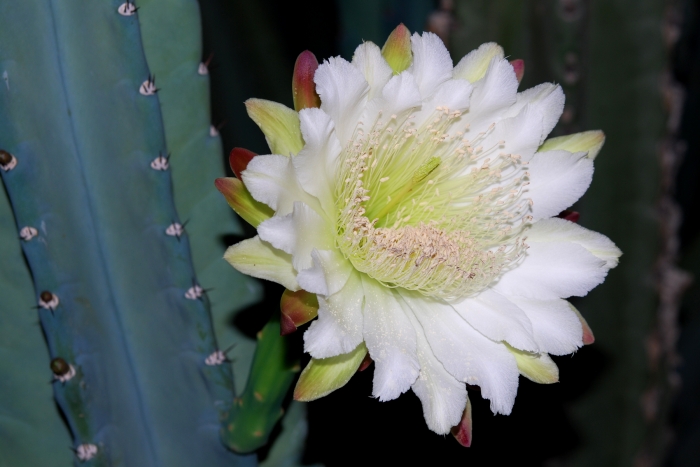Peruvian Apple Cactus
(Cereus hildmannianus)
Peruvian Apple Cactus (Cereus hildmannianus)
/
/

Geoff Gallice from Gainesville, FL, USA
CC BY 2.0
Image By:
Geoff Gallice from Gainesville, FL, USA
Recorded By:
Copyright:
CC BY 2.0
Copyright Notice:
Photo by: Geoff Gallice from Gainesville, FL, USA | License Type: CC BY 2.0 | License URL: https://creativecommons.org/licenses/by/2.0 | Uploader: File Upload Bot (Magnus Manske) | Publisher: Wikimedia Commons | Title: Cereus_hildmannianus_subsp._uruguayanus.jpg | Notes: |





































Estimated Native Range
Summary
Cereus hildmannianus, commonly known as Peruvian Apple Cactus, is an evergreen cactus native to South American scrublands and dry forests. It can reach up to 10 meters (33 feet) high, resembling a tree with a clear trunk and branching freely. The white, nocturnal flowers are exceptionally large, spanning 25–30 cm (10–12 inches) and bloom from October to February, closing in the morning. These flowers are quite showy and are followed by spherical fruits that ripen to a red or yellow color, containing a sweet, white pulp that is edible. The cactus begins flowering at 4 to 5 years old and is particularly abundant during summer nights.
The Peruvian Apple Cactus is valued for its architectural form, large, fragrant flowers, and edible fruits. It is used in xeriscaping, as a specimen plant in cactus and succulent gardens, and for tropical effects in landscapes. It requires minimal maintenance once established and is drought-tolerant. This species prefers full sun and well-draining soil, and while it can tolerate some cold, it must be kept dry during colder periods to prevent root rot. Young plants should be protected from intense sunlight. It is important to water abundantly during the growth period and sparingly during rest. Potential problems include root rot if overwatered or if the soil does not drain well, and it may be susceptible to pests such as scale insects.CC BY-SA 4.0
The Peruvian Apple Cactus is valued for its architectural form, large, fragrant flowers, and edible fruits. It is used in xeriscaping, as a specimen plant in cactus and succulent gardens, and for tropical effects in landscapes. It requires minimal maintenance once established and is drought-tolerant. This species prefers full sun and well-draining soil, and while it can tolerate some cold, it must be kept dry during colder periods to prevent root rot. Young plants should be protected from intense sunlight. It is important to water abundantly during the growth period and sparingly during rest. Potential problems include root rot if overwatered or if the soil does not drain well, and it may be susceptible to pests such as scale insects.CC BY-SA 4.0
Plant Description
- Plant Type: Shrub, Tree
- Height: 10-15 feet
- Width: 5-10 feet
- Growth Rate: Slow
- Flower Color: White
- Flowering Season: Spring
- Leaf Retention: Evergreen
Growth Requirements
- Sun: Full Sun
- Water: Low
- Drainage: Fast
Common Uses
Bird Garden, Drought Tolerant, Edible*Disclaimer: Easyscape's listed plant edibility is for informational use. Always verify the safety and proper identification of any plant before consumption., Fragrant, Low Maintenance, Rock Garden, Showy Flowers
Natural Habitat
Native to South American scrublands and dry forests
Other Names
Common Names: Hedge Cactus, Apple Cactus, Queen-Of-The-Night, Andes Organ Pipe, Pelarkaktus
Scientific Names: , Cereus hildmannianus, Cereus validus, Cereus monstrosus, Cereus childsii, Cactus monstrosus, Cereus pentagonus, Cereus peruvianus var. monstrosus, Cereus abnormis, Cereus peruvianus var. persicinus
GBIF Accepted Name: Cereus hildmannianus K.Schum.